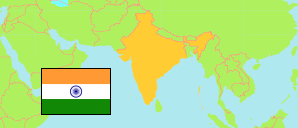
India: Mizoram State
Contents: Districts and Subdistricts
The population of the districts and subdistricts (development blocks) of Mizoram according to the 2011 census.
The  icon links to further information about a selected division including its population structure (gender, urbanization, population group, literacy (a7+), age groups).
icon links to further information about a selected division including its population structure (gender, urbanization, population group, literacy (a7+), age groups).
| Name | Status | Population
Census
2011-03-01 | |
|---|
| Aizawl | District | 387,006 | → |
| Aibawk | Development Block | 17,128 | → |
| Darlawn | Development Block | 26,048 | → |
| Thingsulthliah (Part) | Development Block (Part) | 32,099 | → |
| Tlangnuam (Part) | Development Block (Part) | 311,731 | → |
| Champhai | District | 65,177 | → |
| Champhai | Development Block | 43,040 | → |
| Khawbung | Development Block | 22,137 | → |
| Hnahthial (← Lunglei) | District | 26,113 | → |
| Hnahthial | Development Block | 26,113 | → |
| Khawzawl (← Champhai) | District | 41,838 | → |
| East Lungdar (Part) | Development Block (Part) | 5,907 | → |
| Khawzawl | Development Block | 35,931 | → |
| Kolasib | District | 83,955 | → |
| Bilkhawthlir | Development Block | 58,487 | → |
| 'N' Thingdawl | Development Block | 19,840 | → |
| Tlangnuam (Part) | Development Block (Part) | 5,628 | → |
| Lawngtlai | District | 117,894 | → |
| Chawngte | Development Block | 45,307 | → |
| Lawngtlai | Development Block | 38,722 | → |
| Sangau | Development Block | 16,739 | → |
| S' Bungtlang | Development Block | 17,126 | → |
| Lunglei | District | 135,315 | → |
| Lunglei | Development Block | 77,482 | → |
| Lungsen | Development Block | 39,020 | → |
| West Bunghmun | Development Block | 18,813 | → |
| Mamit | District | 86,364 | → |
| Reiek | Development Block | 17,867 | → |
| West Phaileng | Development Block | 21,309 | → |
| Zawlnuam | Development Block | 47,188 | → |
| Saiha | District | 56,574 | → |
| Saiha | Development Block | 35,531 | → |
| Tuipang | Development Block | 21,043 | → |
| Saitual (← Aizawl) | District | 32,033 | → |
| Ngopa | Development Block | 18,730 | → |
| Phullen | Development Block | 13,303 | → |
| Serchhip | District | 64,937 | → |
| East Lungdar (Part) | Development Block (Part) | 14,897 | → |
| Serchhip | Development Block | 44,242 | → |
| Thingsulthliah (Part) | Development Block (Part) | 5,798 | → |
| Mizoram | State | 1,097,206 | |
Source: Office of the Registrar General and Census Commissioner.
Explanation: States and districts in the boundaries of 2023; subdistricts in the boundaries of 2011. Population figures of new delimitated districts and split subdistricts are mostly computed by using subdistricts or villages in the boundaries of 2011. Thus, slight deviatiations from the actual population are possible in some cases. Area figures are mostly derived from geospatial data.
Further information about the population structure:
| Literacy (A7+) (C 2011) |
|---|
| yes | 848,175 |
| no | 329,531 |
